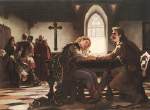

After his studies in Vienna, he went to Paris where his art underwent a major transformation. Péter Zrinyi Arrested, his first picture painted in Paris, proves that he was aware of light effects and movements. Zrinyi, a study (1858) is even more effectful: it is the idealised picture of a national type which is not a portrait in the proper sense of the word. It was then followed by The Mourning of László Hunyadi (1859), perhaps his most beautiful work: the corpse covered with a shroud is lying in a gloomy chapel, his mother and bride are kneeling at his feet. The corpse expresses the injustice which had been done the Hungarian nation and the excruciating pain of the presence. The subdued drama recalls ballads as if the artist had wanted to disclose the tragedy of the Hungarian nation. The picture was awarded the Grand Prix of the Salon in Paris as a proof of French critics understanding qualities of the picture.
On his return, he painted Ilona Zrinyi Before the Judges and Zrinyi and Frangepán in the Prison in Wiener Neustadt (1863), the latter one retaining much of the subdued drama characteristic of The Mourning of László Hunyadi. Men sentenced to death who are controlling their pain, and contours of repulsive looking Austrian aristocrats clearly express the attitude of the artist. The badly organised composition of Dobozy and his Wife does not ruin the effect of the picture, the way Madarász lights the picture and dynamism of galloping represent the highest standard of the age. The same subdued excitement is present in Dózsa's People (1868): supporters of Dózsa remove his corpse from the gallows in the dim light of the night. Pain and horror fill the picture with flashing contours and daring lighting effects. Unfortunately, the picture was not understood in Hungary at the age of the compromise of 1867.
Madarász retired, painted few pictures and became isolated. He painted Resurrection, a picture recalling Petőfi's figure, one of the most popular pictures with its theatrical pathos, exaggerated emotions, it still expresses a passionate dedication characteristic of Madarász. In addition, he was one of the most involved portrait painters, yet he never became popular enough to receive commissions.